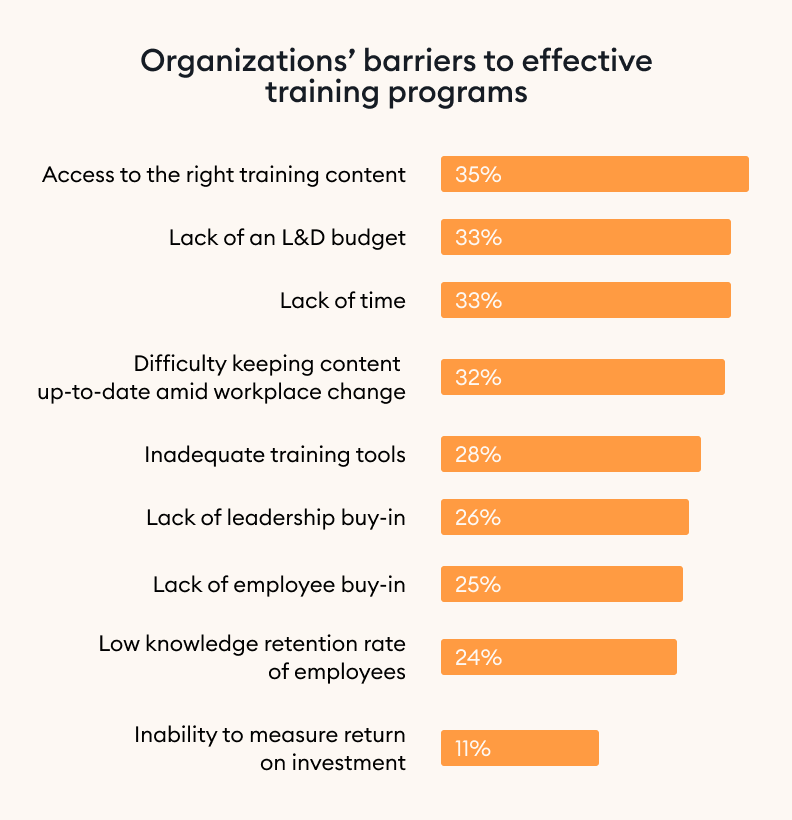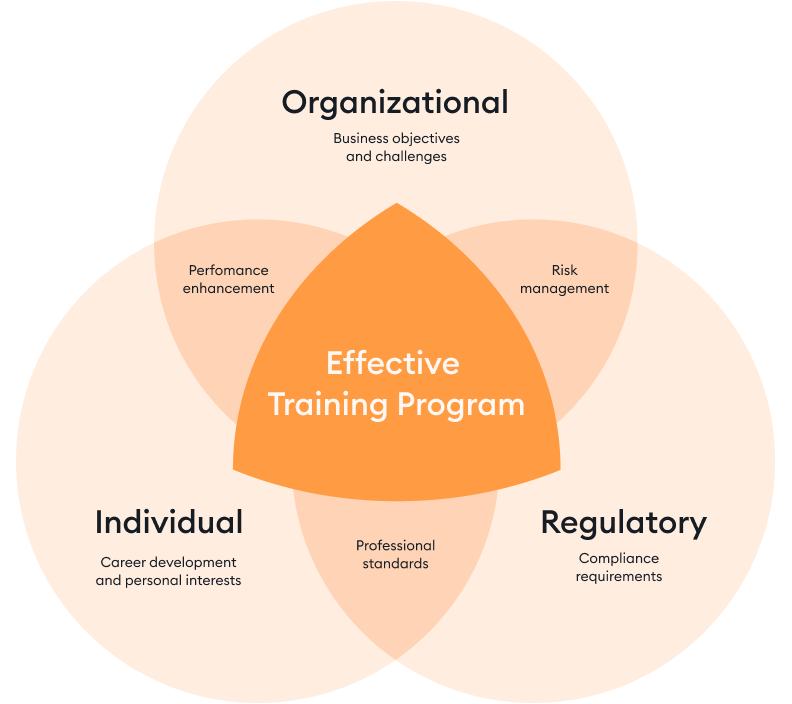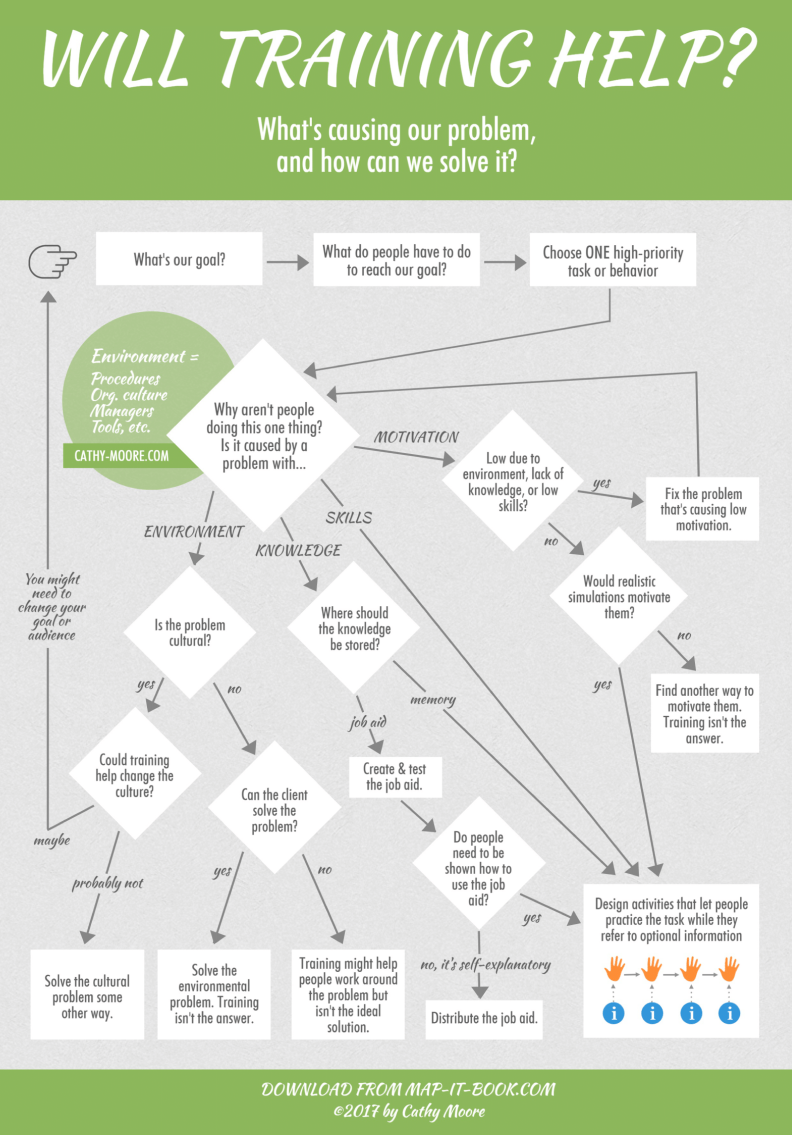How to Conduct a Training Needs Assessment (+ Template)

Before we dive into our guide, download the training needs analysis template so you can use the resources we reference in this article.
According to SHRM research on workplace L&D trends, 33% of HR managers cite lack of time as a top barrier to effective training and skill development programs, followed by insufficient leadership support (26%) and low employee buy-in (25%).

Whether you have a stakeholder training request or need to plan a training budget, a training needs assessment helps avoid these obstacles and ensures training program effectiveness. A training needs assessment creates a clear roadmap to achieve business objectives and satisfy the specific training needs of your employees.
However, despite its importance, a training needs assessment may seem too time-consuming or resource-intensive to fit into your schedule. To make the process easier, we’ve provided a structured workflow, essential tools, and a ready-to-use template.
What Is a Training Needs Assessment?
A training needs assessment (TNA) is a systematic process for determining the gap between current and required employee knowledge and skills to achieve organizational goals and improve job satisfaction.
The desired state refers to the desired level of knowledge, skills, or competencies that employees should possess to perform their jobs effectively or to achieve organizational goals.
In practice, the corporate training needs assessment process involves surveys and interviews with and observations from stakeholders, managers, and employees, followed by an analysis of their responses to determine training needs.
The process isn’t only about clarifying what training is required. It facilitates understanding if a problem can be resolved by designing targeted training programs. Sometimes, changes to the work environment, tools, or processes are needed instead.
Training needs assessment helps you avoid spending the training budget in vain, tie your training plan to business objectives and training ROI from the very beginning, and make informed decisions about future training initiatives based on the data that’s collected.
Training needs assessment vs. skill gap analysis
Within the context of the article, skill gap analysis is included in TNA because employee training isn’t limited to building someone’s skills. For example, training can be motivational, task-based, behavioral change-based, knowledge-based, etc.
Training Needs Assessment Levels
TNAs are typically conducted at three distinct levels: organizational, individual, and regulatory. You need to conduct a training needs assessment across all levels because:
1) Training is expected to bring business results.
2) Employees should be invested in the training to be motivated to learn properly and implement new knowledge.
3) You obviously need to ensure legal compliance.

Organizational
Organizational-level TNA identifies priority business objectives and assesses whether training is the right solution. If so, it determines which teams or job roles need training and the specific skills required to achieve the business objective.
Individual
Individual-level TNA focuses on understanding an employee’s career aspirations, personal interests, and current skill set. This level ensures that a training program supports individual growth, enhances job satisfaction, and boosts employee performance, contributing to both personal and organizational success.
Regulatory
Regulatory-level TNA identifies whether the organization adheres to regulatory requirements, internal policies, and industry standards. By identifying any compliance gaps, regulatory-level TNA helps mitigate legal risks, avoid penalties, and ensure that employees are properly trained to follow these regulations in their daily work.
Training Needs Analysis Template
To help structure and analyze your training needs assessment research findings, here is our free training and current needs analysis template with a set of worksheets.
Download the training needs analysis template (if you haven’t already).
How to Conduct a Training Needs Assessment
Now that you understand the three levels of training needs assessment, let’s explore how to integrate them into a training needs assessment process.
These 5 steps will guide you to a data-driven list of potential training options to present to stakeholders.
The full process typically takes 3-6 weeks for a midsized organization. However, you can speed it up by focusing on key priorities and using surveys instead of focus group interviews where possible.
Step 1: Figure out organizational needs
At this stage, your goal is to determine whether the requested training is the right solution to the problem and where training is most needed to support the company’s objectives.
To do this, start by conducting interviews with stakeholders to prioritize business challenges and objectives.
To gather insights, ideally, schedule individual interviews or calls with stakeholders. If their pool is large, consider sending emails or running a survey instead. Additionally, use the Interview with Stakeholders Worksheet from our training needs assessment template (available later in the article) to structure your discussions.
Lastly, consult compliance, legal, and security departments to ensure you account for any regulatory requirements.
When training is not (might not be) the answer
Use techniques like the 5 Whys to trace the root cause of the problems at hand. While managers often default to training as a universal solution, many workplace challenges can be more easily and cost-efficiently resolved by improving existing processes.
For example, when a team struggles with time-consuming weekly key performance indicator reports, a manager might immediately consider report-writing training. However, this initial assumption could mask the real issue. In this case, executives might actually prefer less frequent but more detailed reports — making a simple process change the better solution than training.
During the whole analysis process, it’s crucial to be open to any signs that there can be other ways to achieve the same goal:
- Making changes in work routines
- Starting or canceling procedures
- Implementing better equipment or software
- Launching on-the-job coaching instead of formal training
- Providing employees with job aids, etc.
Cathy Moore, an internationally recognized instructional designer, created a flowchart that can help you determine the best solution to a performance problem or business objective.

Plus, don’t forget that doing nothing is also an option. What will the consequences be if you don’t launch a training program and don’t change anything? The answer to this question helps you understand the true importance of the issue. For a nuclear power plant, enhanced workplace safety training is the top priority. But for an office, it might be a mere formality.
At the end of the research, you need to have a prioritized list of problems that require training to support the organization’s goals.
Step 2: Specify your target audience
Once you’ve defined your business goals, the next step is to research which skills and knowledge will drive training effectiveness. This research helps identify which employees or groups need practical training most urgently.
Start by establishing measurable outcomes for each business objective and mapping them to specific teams and roles responsible for these performance metrics.
Next, conduct comprehensive research to define relevant job behaviors and gaps in skills:
- Study industry trends and standards.
- Analyze what top performers do differently.
- Interview managers and employees about challenges and needs.
To structure this research, use the Interview with Employees Worksheet and Gap Analysis Template from our training needs assessment template. The 9-box grid can also be helpful in assessing employees’ current skills, potential, and readiness for development.
This approach ensures that your investment in training will target the most critical needs for maximum impact.
For large, diverse audiences, consider segmenting the training content to match the specific needs and skill levels of different subgroups. This customization helps to maintain relevance and engagement across all participant groups.
By the end of the research, you should have a list that maps critical skills to business objectives and which roles or teams need to develop each skill.
Step 3: Identify employees’ individual needs
This step is super important for creating a successful training program. If employees aren’t engaged in learning, even the best-designed program won’t improve job performance levels or help achieve organizational goals.
According to research, 80% of employees expected personalized learning in 2024 — and with the emerging tech that makes this scalable, organizations are increasingly adopting individualized learning strategies to meet employee expectations.
So, once you understand who your target audience is, you need to talk to them to figure out how the required skills fit into their career aspirations and personal interests. “What’s in it for them?”
If you have employee development plans, great! Keep them for the next step of the training needs assessment.
If you don’t have these learning strategies in place, you can conduct surveys, questionnaires, or calls with a focus group. Ask questions such as:
- What motivates you to learn something new?
- What career growth opportunities interest you most?
- What knowledge gaps do you feel are holding you back?
- What topics or skills are you personally excited to learn?
- What industry trends or developments interest you most?
Step 4: Figure out potential solutions
At this step, combine your identified skill gaps and employee preferences to outline potential training methods that serve both organizational goals and individual development needs.
When possible, prioritize training options that both contribute to business objectives and align with employees’ interests. If this isn’t possible, focus on:
- Highlighting how the training will benefit their career growth.
- Demonstrating how it will make their work easier and more satisfying.
- Selecting training methods that match their preferred learning styles.
- Adapting training delivery methods to keep engagement high.
Also, look for ways to fulfill employees’ personal interests. This might include:
- Providing access to ready-made courses on topics they’re passionate about.
- Offering learning subscriptions that cover both required and interest-based training recommendations.
- Adding optional advanced modules to mandatory employee training.
This balanced approach ensures that you develop the necessary skills while maintaining motivation and employee engagement throughout the learning process.
When creating a list of possible training solutions, consider the following:
- Your team’s capacity to develop specific training programs, including their expertise and available time.
- Whether you have internal subject matter expertise to conduct the training.
- Your allocated training budget and its timeline constraints.
- The total cost of the training implementation process and the expected timeline for achieving business results.
- Training urgency, with priority given to regulatory and safety requirements.
- The potential to update existing training materials to address newly identified needs.
This step should result in a list of potential learning programs.
Training needs assessment example
Here is an example of matching organizational and employee needs from Ashley Dugger, Senior HR Business Partner at Bucknell University.
Business need:
- A global company is unable to meet production goals due to recruitment challenges; consequently, critical positions remain unfilled, affecting consumer demand.
Skills analysis for the recruitment team: Ability to guide hiring managers through the requisition function in the applicant tracking system, compliant interview techniques, crafting behavioral analysis questions, and developing realistic day-in-the-life interview scenarios.
The solution is aligned with the talent acquisition specialist’s personal growth: they want to move into talent management/L&D.
So, the training plan:
- Teaches global compliance and cultural requirements
- Develops their training skills by having them create hiring manager workshops
- Measures training effectiveness through metrics:
1) Time to fill positions
2) 30-day turnover rates
3) Quality of hire
Step 5: Report your findings
Organize a meeting to present your findings to decide on the employee training program you will create and get the approval of the stakeholders. Create 5 concise slides to showcase your research insights and training options you’ve developed:
- Present discovered business training priorities.
- Showcase what skills are required to achieve the stated business goals.
- Explain which employees need the training program and why.
- Tie your suggested training opportunities to training objectives and business outcomes.
- Include an implementation timeline and resource requirements.
Training Needs Assessment Automation Tool
If manual training needs analysis seems overwhelming for your organization, consider using an LMS with integrated 360-degree assessment. This automated approach can significantly reduce the workload while providing comprehensive insights into your training needs.
For example, iSpring Learn automates everything from sending survey assignments and notifications to preparing final reports. Plus, the employee feedback is collected anonymously, which encourages respondents to be honest and helps uncover valuable insights.
The platform’s ability to regularly reassess current skills also makes it easier to track progress and adjust training plans as needed.
Performing a 360-degree assessment in iSpring Learn will be especially helpful for steps 2 and 3 of the assessment:
- The competency radar feature visualizes skill levels across different teams and roles.
- Anonymous feedback from peers, project management teams, and subordinates provides a more complete picture of skills needed to achieve company objectives.
- The self-assessment component allows the workforce to evaluate their own skills and core competencies.

What’s Next?
Once you have identified training needs, you’re ready to:
1) Choose the most effective training methods by taking into account the type of training program you have chosen, your training budget, the target audience’s learning style, and their work routine.
2) Develop a training program based on chosen training opportunities.
3) Regularly update your training needs assessments. If there are no triggers that require new needs assessments, conduct them annually or semi-annually to keep employee training programs effective.
Remember, you don’t need a large-scale training needs assessment if you don’t have time or budget. You can start small, focusing on the most critical business and employee needs.
Note: If you don’t get buy-in for conducting a training needs assessment, you can start with your team and use this as a case study to interest other departments in your organization.
Feel free to ask any questions you may have or share any advice we didn’t mention in the article by leaving them in the comment section below!







